SAINT MICHAEL THE ARCHANGEL WITH THE DEVIL
Further images
-
(View a larger image of thumbnail 1
)

-
(View a larger image of thumbnail 2
)

-
(View a larger image of thumbnail 3
)

-
(View a larger image of thumbnail 4
)
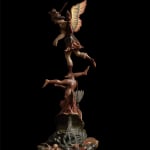
-
(View a larger image of thumbnail 5
)
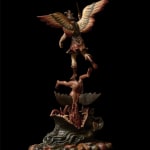
-
(View a larger image of thumbnail 6
)
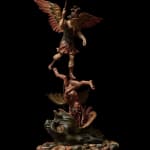
-
(View a larger image of thumbnail 7
)
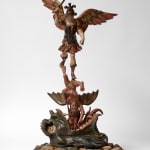
-
(View a larger image of thumbnail 8
)

-
(View a larger image of thumbnail 9
)
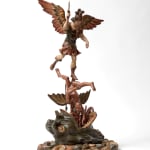
-
(View a larger image of thumbnail 10
)

Provenance
Private collection, Spain
With its striking verticality, this free-standing sculpture in carved and polychromed wood stands on a sort of plinth consisting of a fish’s head with its mouth wide open, over which a naked devil is hanging, head first, held up by a large-winged armed angel wearing a helmet and brandishing a sword in his right hand.
What is particularly remarkable in terms of composition is the sense of light, almost helicoidal, upwards movement, and the division of the work into two clearly-differentiated sections: in the lower half, this fish/dragon hybrid with long fangs, clearly reminiscent of Baroque European models, alongside the terrified devil hanging in the creature’s jaws, with its divergent compositional lines, bear witness to the fantastical and innovative tastes that predominated in New Spain . In the upper half, St. Michael is depicted in accordance with rather more politically correct parameters, with few variations from the artistic canon arriving directly from Europe. The work thereby achieves a magnificently heightened contrast, far more than the majority of pieces depicting this subject, between the celestial and the infernal. Between good and evil.
Between the sacred and the profane. A dichotomy that is perfectly expressed and which, being a device more often resorted to in painting, is attained here in a sculptural work, lending the piece a rarity value we should take into account as it attests to its quality.
By 1700, art in the viceroyalty not only boasted great skill, but had also won fame in Spain and the rest of Europe. In any case, the 17th and particularly 18th centuries were deeply and unmistakeably marked by the major social changes taking place, which inevitably had a direct impact on artistic output. “Mestizo” elements, or the presence of black slaves, constituted a reordering of indigenous society. Local artisans played an ever-increasing role, grouped into newly formed guilds with their own norms and organisation. Syncretism between the two cultures can be clearly seen giving rise to a new, homegrown, style, with the Baroque giving way to a new modernity, where influences moved in both directions, as can be seen in the magnificent exemplar we are presenting here.









